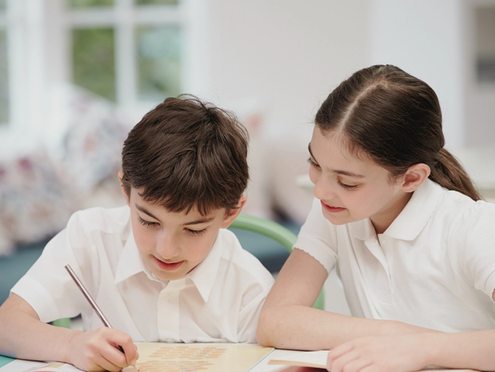In this blog, we explain the mastery approach for parents who would like to know more about it. Find out what to expect if your child is being taught through the mastery approach.
What is mastery in learning?
This approach requires learners to master around 80 percent of the subject matter before moving on to learning new information. The intention of this method is to maximise the long-term retention of knowledge, giving learners the best chance of developing a deep understanding of the subject matter, and perhaps even to go on and become experts in it as adults.
In the mastery approach, teachers break down the topic into smaller blocks and go over the material in depth until learners are completely comfortable with it and they have achieved the required level of knowledge. This involves setting rigorous learning objectives and using regular assessments as indicators of progress and knowledge retention.
Although the mastery approach is used to teach whole classes, differentiation is always applied so that the needs and abilities of all learners are met. The individualised learning that differentiation ensures means that learners who absorb information more quickly continue to be challenged with extension tasks, as well as giving students who do not learn as quickly the extra support they need - not only does this stretch high-achieving learners, but it supports those who are statistically less likely to achieve, such as those from disadvantaged backgrounds and learners accessing the Pupil Premium.
The theory of mastery learning was largely developed by the American educational psychologist Benjamin Bloom in the 1960s. Bloom conducted in-depth studies on the learning process and the acquisition of knowledge, and concluded that it is hard work and consistent studying over a long period of time that leads to mastery of a subject, rather than a learner being gifted or having a natural aptitude for it.
Bloom’s findings played a pivotal role in changing how achievement is measured in schools and resulted in a shift towards deep, detailed instruction and a focus on long-term retention, rather than success being associated with how quickly learners get through the material.
What are the key features of the mastery approach?
The mastery approach aims to help learners of all levels of ability obtain an in-depth understanding of the topic being taught and retain this knowledge in their long-term memory. Emphasis is placed on detailed, thorough teaching of the material, which is broken down into smaller sections and tackled one step at a time - chunking. As a parent, you may be concerned that the pace of the teaching may not be suitable for every child in the class, but on the contrary, the mastery method is delivered in a way that means no child is ever bored waiting for others to catch up, nor is any learner left struggling to keep up.
If successfully implemented, the mastery approach has the following key features:
- Emphasis on depth of learning, not speed
- Detailed teaching with topics divided into manageable sections
- High-quality whole class teaching with differentiation strategies in place
- Stimulating extension activities to further challenge learners
- Targeted support to ensure no child is left behind
- Peer support and cooperation encouraged
How effective is mastery learning?
Extensive studies have been conducted on the impact of mastery in learning. According to a report by the Education Endowment Foundation (EEF), the effectiveness of the mastery approach varies across different studies, but it does yield largely positive results, particularly for primary school pupils. The EEF report found that its impact is greater when high-quality direct instruction from teachers is combined with a degree of collaborative learning, where learners are given the chance to work together in groups or be supported by their peers.
Earlier studies by Bloom also indicated that the mastery method can increase a student’s confidence in their own ability, as well as providing reassurance: learners get a second chance to succeed if they do not manage to attain the required level of subject knowledge at the first attempt.
Overall, the key benefit of applying the mastery approach is the role it plays in decreasing the attainment gap between learners, which is acknowledged in the Oxford Language Report (2021-2022). By valuing proficiency over speed, lower-attaining learners are able to catch up to their peers without those learning at a faster pace feeling like they are being slowed down.
What do parents need to know about how the mastery method is taught?
As a parent of a child being taught using the mastery method, it is understandable that you may question whether certain aspects of this approach are right for your child, depending on their current level of attainment and their preferred learning style. Please be assured that this teaching and learning method is designed to suit all abilities, providing ample opportunities to challenge higher attaining learners, as well as helping to increase the attainment of children who are not progressing at the same level. No matter the ability level of your child, the mastery approach personalises instruction to ensure every learner’s success.
Teachers can swiftly identify any gaps in understanding and provide tailored support to learners who are struggling, in addition to ensuring higher level learners are continually stimulated through additional tasks and deeper exploration of the topic. Rather than creating a competitive atmosphere in which some learners may feel out of touch, the mastery approach promotes collaboration and peer support between classmates when group work is combined with teacher-led instruction.
You may also find that your child seems to be spending a long time on the same topic - this does not mean that their learning is becoming stagnant or repetitive in any way. On the contrary, because the mastery approach emphasises depth of understanding rather than how quickly modules are completed, your child will be developing a much more comprehensive knowledge of the topic; this will stay with them for years to come.
What role can parents and families play in mastery learning?
There are many ways you can support your child at home to build on the good work being done in class.
You can support your child with homework activities and assist them in designing their own practice tasks. You can also ask them to explain from their own perspective on the key facts about a topic, or demonstrate how a process works, depending on what they are learning. By taking an interest in their progress and supporting your child to consolidate their learning at home, you help them to achieve realistic goals and increase their level of proficiency in the topic they are studying.
How does Bedrock's curriculum support the mastery approach?
Bedrock’s deep-learning algorithm is formed around the foundations of the mastery approach.
One of the drawbacks of implementing the mastery approach in all schools is that it can be time consuming. Spending as much time as is needed on a topic to achieve mastery boosts long-term retention, but in some cases can result in teachers not covering every topic. This is especially true as teachers become tighter on time spent in the classroom.
For this reason, Bedrock’s digital literacy curriculum implements the mastery approach into its algorithm. This means that learners reap the benefits of mastery without extra time spent in the classroom, saving teachers time and deepening retention.
In Bedrock’s core curriculum, topics are recapped consistently to ensure learning is interleaved and knowledge is revised. As well as this, if learners do not succeed in a lesson the first time around, there are opportunities to refresh the learning and give assessments another try.
Also crucial in the mastery approach, Bedrock’s core curriculum uses frequent low-stakes assessments to track progress and provide insightful data, giving teachers and parents visibility of a student’s learning.
In Bedrock’s grammar curriculum in particular, the success rate of a lesson or topic is tracked using two metrics - understanding, which is 60%, or mastery, which is 80%. Topics are recapped until mastery is achieved and learners have full, automatic understanding of new literacy skills.
This mastery approach is mirrored on Bedrock Mapper, helping learners to revise the vocabulary they need for learning in every subject.
Summary
When applied properly, the mastery approach in teaching and learning offers a range of benefits: bridging attainment gaps, increasing the long-term retention of knowledge, and building learners’ confidence in their own abilities over time.
Mastery in learning focuses on the quality, rather than the quantity, of knowledge that is being acquired, and requires a consistent commitment to studying a topic in depth. Parents can support learners at home by providing motivation, using engaging activities, encouraging them to practise what they have learned, and acknowledging their achievements and their progress; the most effective tool a parent or guardian can use to support their child’s learning is your attention and involvement in their success.


